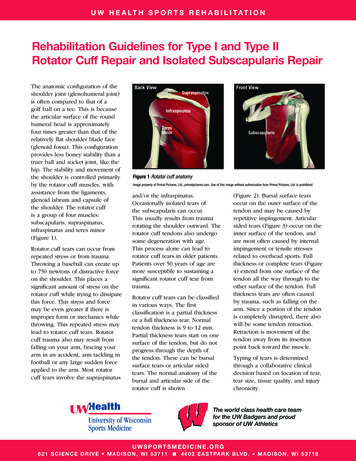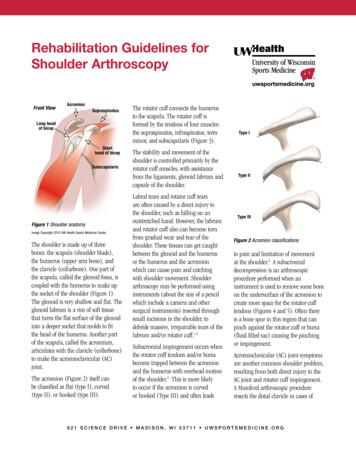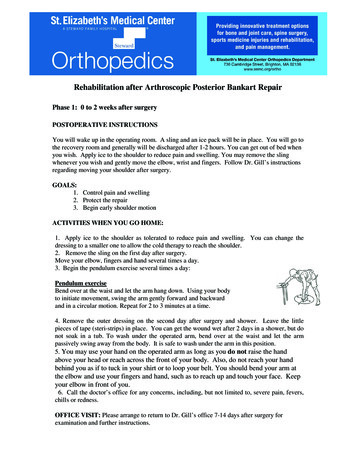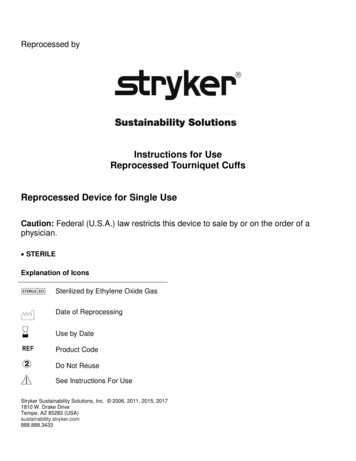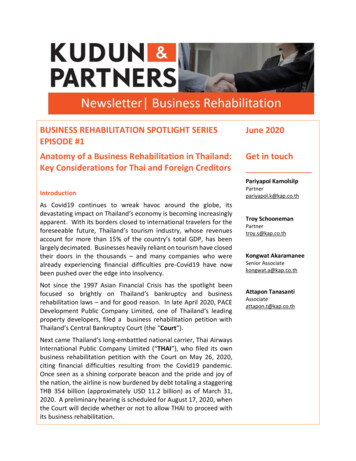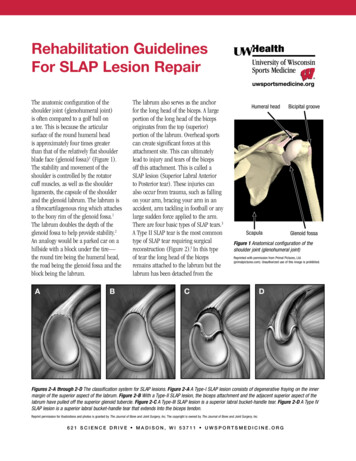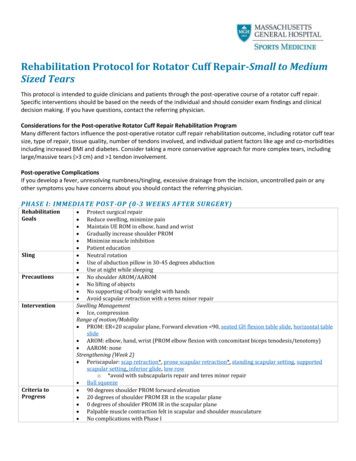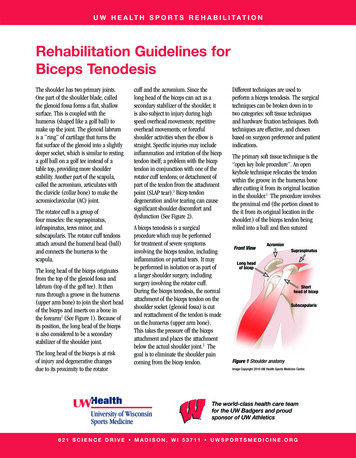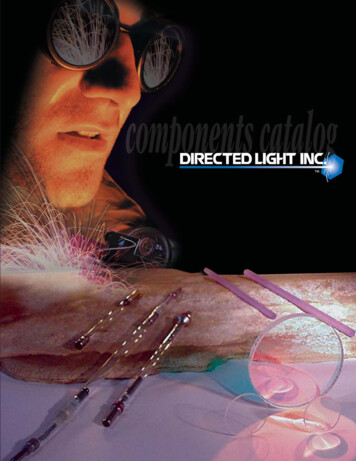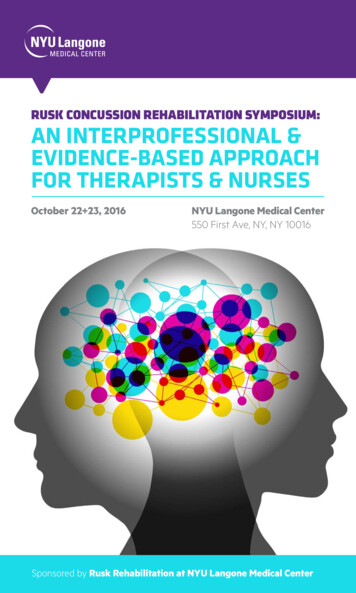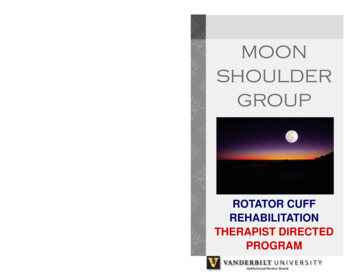
Transcription
MOONSHOULDERGROUPFor information regardingthe MOON Shoulder Groupspeak to the referring physicianor contact:Rosemary Sanders1215 21st Avenue South6100 Medical Center EastVanderbilt University Medical CenterNashville, TN 37232-8300615.936.5191Version 3 (Revised Date 8.12.2008)Date of IRB Approval: August 21, 2008ROTATOR CUFFREHABILITATIONTHERAPIST DIRECTEDPROGRAM
IntroductionThe Shoulder MOON group is a Multi-center Orthopaedic OutcomesNetwork, a consortium of institutions working together to bringpatients the best possible care with disorders of the shoulder.The patient before you is participating in a study to determine theeffectiveness of physical therapy in treating rotator cuff tears. It isessential that he or she follow this rehabilitation program very closely.This rehabilitation program has been distilled from seven Level 1 orLevel 2 randomized controlled trials that demonstrate benefits fromphysical therapy for treating rotator cuff pain. Please follow thisprogram carefully.Do not add, alter, or skip any of the treatments in this protocol.The therapist can provide instruction on patient directed active rangeof motion, patient directed flexibility, and patient directedstrengthening. There is evidence that manual therapy can be helpfulat improving outcomes and should be included at the discretion of thetherapist (see page 10). When the patient no longer needs manualtherapy and is ready to continue the exercise program at home, he orshe can be moved to a home exercise program, as there is evidencethat home exercise programs can be as effective as regular physicaltherapy visits.HOME REHABILITATIONPatients in whom manual therapy is no longernecessary can be moved to a home exercise program.Movement to a home program is at the discretion of thephysician and therapist.Please instruct the patient in proper form and techniquefor the exercises listed in this booklet and on thepatient’s instructional DVD. Do not add or remove anyexercises. Please set up a progression program. If thepatient has any questions, please instruct him/her tocontact his/her physician.If you have questions, please contact the referringMOON physician or contact the study coordinator (seeback cover for contact information).Thank you for your participation in this research effort!Patients should perform the strengthening exercises three timesper week. Range of motion and flexibility exercises can beperformed daily.ModalitiesWith regard to modalities, some of these exercise programs usedheat and cold. Thermal modalities should be applied for 15 minutesbefore and after exercise. There is limited evidence to support theuse of electrotherapy. There is no evidence to support the use ofultrasound.Date of IRB Approval: August 21, 2008
Therapist Directed Manual TherapyIn patients who have limited range of motion or whootherwise might benefit, some well designed studies with ahigh level of evidence suggest that manual therapy is ofbenefit. This manual therapy is primarily aimed at shoulderbut may be directed to the shoulder girdle, the cervical spine,and the upper thoracic spine. In most cases passiveaccessory or passive physiologic joint mobilization Maitlandgrades I-IV is used. Maitland Mobilization Techniques areperformed 2-4 times at 30 seconds each with two or threeoscillations per second with the grade of stretch determinedby the patients response and end feel testing, and shouldinclude:-Inferior glide-Anterior glide-Posterior glide-Long axis tractionThe goals are to:-Enhance glenohumeral caudal glide in positions of flexion orabduction and-Increase physiological flexion or internal rotationIf a patient reaches a plateau:-Change the vigor of the technique used-Change the technique-Direct treatment toward the relevant movement limitations.ReferencesBang M, Deyle G. Comparison of supervised exercise with and withoutmanual physical therapy for patients with impingement syndrome. J Ortho Sports Phys Ther 2000;30(3):126-137Binder A, Parr G, Hazleman B. Pulsed electromagnetic field therapy ofpersistent rotator cuff tendonitis. Lancet 1984;1(8379):695-698Brox J, Staff P, Ljunggren A, Brevik J. Arthroscopic surgery comparedwith supervised exercises in patients with rotator cuff disease. BMJ1993;307(6909):899-903Brox JI, Gjengedal E, Uppheim G, Bohmer AS, Brevik JI, Ljuggren AE,Staff PH. Arthroscopic surgery versus supervised exercises in patientwith rotator cuff disease (stage II impingement syndrome): A prospective,randomized, controlled study in 125 patients with a 2 ½ year follow-up. JShoulder Elbow Surg 1997;8(2):102-111.Conroy DE, Hayes KW. The effect of mobilization as a component ofcomprehensive treatment for primary shoulder impingement syndrome. JOrtho Sports Phys Ther 1998;28(1):3-14.Desmeules F, Cote CH, Fremont P. Therapeutic exercise and orthopaedic manual therapy for impingement syndrome. A systematic review. ClinJ Sports Med 2003:13:176-82.Ginn KA, Herbert RD, Khouw W, Lee R. A randomized, controlled trial ofa treatment for shoulder pain. Phys Ther 1997;77(8):802-811.Grant HJ, Arthur A, Pichora DR. Evaluation of interventions for rotatorcuff pathology: a systematic review. J Hand Ther 2004; 17(2):274-299Green S, Buchbinder R, Hetrick S. Physiotherapy interventions for shoulder pain. Cochrane Database of Systematic Reviews 2003 Volume 2:CD004258.Typical treatment during subsequent visits should focus on:-Improving the combined physiologic movements of handbehind back or shoulder quadrant-Increasing upper thoracic extension or side bend-Enhancing extension, rotation, or side bend of the cervicalspine.Haahr JP, Ostergaard S, Dalsgaard J, Norup K, Frost P, Lausen S, HolmEA, Andersen JH. Exercises versus arthroscopic decompression in patients with subacromial impingement: a randomised, controlled study in 90cases with a one year follow up. Ann Rheum Dis. 2005Techniques may also include soft tissue massage andmuscle stretching, particularly of the pectoralis minor,infraspinatus, teres minor, upper trapezius,sternocleidomastoid, and scalenes musculatures. Effleurage,friction and kneading techniques may also be employed withthe subject sitting and the arm supported loosely.Michener LA, Walsworth MK, Burnet EN. Effectiveness of rehabilitationfor patients with subacromial impingement syndrome: A systematic review. J Hand Ther 2004; 17(2):152-164Date of IRB Approval: August 21, 2008Ludewig PM, Borstad JD. Effects of a home exercise programme onshoulder pain and functional status in construction workers. Occup Environ Med 2003;60:841-9.Van Der Heijden GJ, Physiotherapy for patients with soft tissue disorders:a systematic review of randomized clinical trials. BMJ 1997;315: 25-30
Therapist Directed Manual TherapyIn patients who have limited range of motion or whootherwise might benefit, some well designed studies with ahigh level of evidence suggest that manual therapy is ofbenefit. This manual therapy is primarily aimed at shoulderbut may be directed to the shoulder girdle, the cervical spine,and the upper thoracic spine. In most cases passiveaccessory or passive physiologic joint mobilization Maitlandgrades I-IV is used. Maitland Mobilization Techniques areperformed 2-4 times at 30 seconds each with two or threeoscillations per second with the grade of stretch determinedby the patients response and end feel testing, and shouldinclude:-Inferior glide-Anterior glide-Posterior glide-Long axis tractionThe goals are to:-Enhance glenohumeral caudal glide in positions of flexion orabduction and-Increase physiological flexion or internal rotationIf a patient reaches a plateau:-Change the vigor of the technique used-Change the technique-Direct treatment toward the relevant movement limitations.ReferencesBang M, Deyle G. Comparison of supervised exercise with and withoutmanual physical therapy for patients with impingement syndrome. J Ortho Sports Phys Ther 2000;30(3):126-137Binder A, Parr G, Hazleman B. Pulsed electromagnetic field therapy ofpersistent rotator cuff tendonitis. Lancet 1984;1(8379):695-698Brox J, Staff P, Ljunggren A, Brevik J. Arthroscopic surgery comparedwith supervised exercises in patients with rotator cuff disease. BMJ1993;307(6909):899-903Brox JI, Gjengedal E, Uppheim G, Bohmer AS, Brevik JI, Ljuggren AE,Staff PH. Arthroscopic surgery versus supervised exercises in patientwith rotator cuff disease (stage II impingement syndrome): A prospective,randomized, controlled study in 125 patients with a 2 ½ year follow-up. JShoulder Elbow Surg 1997;8(2):102-111.Conroy DE, Hayes KW. The effect of mobilization as a component ofcomprehensive treatment for primary shoulder impingement syndrome. JOrtho Sports Phys Ther 1998;28(1):3-14.Desmeules F, Cote CH, Fremont P. Therapeutic exercise and orthopaedic manual therapy for impingement syndrome. A systematic review. ClinJ Sports Med 2003:13:176-82.Ginn KA, Herbert RD, Khouw W, Lee R. A randomized, controlled trial ofa treatment for shoulder pain. Phys Ther 1997;77(8):802-811.Grant HJ, Arthur A, Pichora DR. Evaluation of interventions for rotatorcuff pathology: a systematic review. J Hand Ther 2004; 17(2):274-299Green S, Buchbinder R, Hetrick S. Physiotherapy interventions for shoulder pain. Cochrane Database of Systematic Reviews 2003 Volume 2:CD004258.Typical treatment during subsequent visits should focus on:-Improving the combined physiologic movements of handbehind back or shoulder quadrant-Increasing upper thoracic extension or side bend-Enhancing extension, rotation, or side bend of the cervicalspine.Haahr JP, Ostergaard S, Dalsgaard J, Norup K, Frost P, Lausen S, HolmEA, Andersen JH. Exercises versus arthroscopic decompression in patients with subacromial impingement: a randomised, controlled study in 90cases with a one year follow up. Ann Rheum Dis. 2005Techniques may also include soft tissue massage andmuscle stretching, particularly of the pectoralis minor,infraspinatus, teres minor, upper trapezius,sternocleidomastoid, and scalenes musculatures. Effleurage,friction and kneading techniques may also be employed withthe subject sitting and the arm supported loosely.Michener LA, Walsworth MK, Burnet EN. Effectiveness of rehabilitationfor patients with subacromial impingement syndrome: A systematic review. J Hand Ther 2004; 17(2):152-164Date of IRB Approval: August 21, 2008Ludewig PM, Borstad JD. Effects of a home exercise programme onshoulder pain and functional status in construction workers. Occup Environ Med 2003;60:841-9.Van Der Heijden GJ, Physiotherapy for patients with soft tissue disorders:a systematic review of randomized clinical trials. BMJ 1997;315: 25-30
Patient Directed Active and Active AssistedRange of Motion (See pictures on next page)The patient begins with pendulum exercises forthe shoulder. He/she should be instructed to usethe momentum of the body to move the arm.They should be told NOT to use the shouldermuscles. The patient should move the armcounter-clockwise, clockwise, forward and back,and side to side. Do 20 cycles for each motion.External RotationSecure elastic atwaist level. Holdelbow at 90 degreesarm at side. Pullhand away frombody as shown.Internal RotationSecure elastic atwaist level. Holdelbow at 90degrees arm atside. Pull handacross body asshown.ORInternal Rotation—Lieon involved side, elbowbent at 90 degrees,arm at side. With orwithout weight, pullhand inward acrossbody, as shown.External Rotation—Lie on side, involvedside up. Arm at side,elbow bent, with orwithout weight.Move hand up asshownPosture exercises should be done within the painfree range.Active assisted range of motion using a cane ora pulley system. Motions include forwardelevation, external rotation, and abduction. Do 3sets of 10 repetitions. These can be done lyingdown, and when comfortable, have the patient dothem while standing upright.Active training of the scapula muscles(rhomboid, serratus, trapezius, levator scapulae,and pectoralis minor) should be done using theexercises depicted, by doing shoulder shrugs andby pinching the shoulder blades behind. Do 3sets of 10 repetitions.Active range of motion of the shoulder. Musclerelaxation exercise for the upper trapezius areperformed by having the patient raise the arm inthe scapular plane without shrugging the shoulder.Relaxation is enhanced through visual input byperforming in front of the mirror, or byproprioceptive input by placing the uninvolvedhand on the active upper trapezius. The patientshould do 3 sets of 10 repetitions.Date of IRB Approval: August 21, 2008Rows– Seated orstanding, bend elbowsand pull elastic cordback. Try to pinch yourshoulder blades behindyou.Shrugs—Stand withweights in hands. Rollshoulders back and hold.Posterior Deltoid Exercise Lying on stomach, with smallweight in hand, lift arm to sideand holdUpright Row- Do one armat a time. While standinglean over a table. Bend atwaist. Pull hand weightback, pulling shoulderblade back.Low Trapezius-Standupright. Grasp elasticbands. Keep elbowsstraight and pull. Try toreach behind you.Press Up - Lie on back, elbowlocked straight, weights inhands. Move arm up towardceiling as far as possible.Chair Press–While seatedpress up on chairlifting body offchair. Try to keepPushup Plus - Do a pushup(either on your hands or forearms)and then really push to bring yourspine to the ceiling.Jackins’ Exercises are designed for patients with difficulty with forwardelevation. While lying on back lift arm over head, use the other arm tohelp, then use the arm alone, then add 1 or 2 lb weights and repeat.Then raise back 20 degrees and repeat sequence. Keep raising back20 degrees and repeat sequence until upright
Patient Directed Strengthening(See pictures on next page)Strengthening should be done 3 to 4 times each week with 3 sets with 10repetitions for each exercise. Repetitions and or resistance can beincreased as tolerated. Teach and emphasize good form. Patientsexceeding mild discomfort should reduce the level of resistance, or modifythe range of the exercise until they are comfortableenough to progress. Strengthening of the rotator cuffis done within limits of pain.Do NOT have the patient perform full-can or emptycan supraspinatus exercises!Rotator Cuff StrengtheningInternal and External Rotation Isometrics against a wall. Hold pressurefor 20 seconds then rest. Do 3 sets of 10 repetitions.Internal and External Rotation against resistance. Patient stands whenusing elastic bands or lies on side to use hand weights. Keep the armagainst the body. Internally rotate against resistance for internal rotation.Externally rotate against resistance for external rotation. Patients canprogress from an initial position of the arm close to the side, to a positionof abduction of the arm. Try to progress as 3 sets, 10 reps the first week,3 sets of 15 reps the second week, 3 sets of 20 reps the third week. Thenprogress by shortening the band. Exercises should induce fatigue but notcause increased shoulder pain. Increase the resistance (or weight) andthe number of repetitions as tolerated by pain.Postural and Periscapular Muscle Strengthening-Rows– While seated or standing bend elbows and pull elastic cordsback. Try to pinch shoulder blades behind you. An upright row can bedone with a hand weight as directed.-Chair Press-Use arms on bottom of chair or armrests to get out of achair. Hold the position then relax.-Shrugs– Like the posture exercise for range of motion, repeat using handweights.-Press Up—While lying on your back holding hand weights and elbowslocked push up toward the ceiling.-Push Up Plus-With hands or forearms on table, do a pushup, then reallypush to try to touch your spine to the ceiling.-Posterior Deltoid-Lying on your stomach with your arm over the table anda weight in your hand, bring the arm out to the side and hold.Jackins’ ExercisesFor patients with limited active forward elevation, Jackins’ exercises maybe used. Begin lying on your back. Raise the injured arm using theuninjured arm to help do at least 3 sets of 10 repetitions. When this iseasy, practice raising the arm by itself. When this is easy, use a smallweight. When this is easy, raise the head of the bed about 20 degreesand repeat the process. When this becomes easy, raise the head of thebed another 20 degrees and repeat the process again. Continue to raisethe head of the bed and repeat the process until you are lifting weightswhile standing upright.Date of IRB Approval: August 21, 2008Pendulum Exercises:Let the arm dangle. Make 20small counter-clockwise circles.Make 20 small clockwise circles.Make forward and backwardmotions then side to sidemotions.Posture exercises:Put hands on hips, leanback and hold.Active Assisted Range of Motion using a Cane:Lying supine, hold the cane with both hands. Elevate the armsusing the healthy arm to guide the injured arm. Increase the use ofthe injured arm as directed by comfort. These can be done uprightwhen comfortable. Images demonstrate Forward Elevation,External Rotation, and Abduction. Can do standing if comfortable.Active training ofthe scapulamuscles.Shoulder Shrugs:Pull shoulders upand back and hold.Active training of thescapula muscles.Pinch the back of theshoulder bladestogether using goodposture.Active range ofmotion. In front of amirror practice raisingyour arm in front of yourbody without shruggingyour shoulder.
Patient Directed Flexibility(See pictures on next page)Each stretch is 30 seconds each with 10 secondsrest between each stretch, repeat five times perday.Anterior Shoulder Stretches-Door Stretch. The patient’s hands are placed atshoulder height on with the forearms on the doorjamb. The patient leans into the door spacestretching the tissues in front (especially pectoralisminor) This can be done in a corner where twowalls meet, and the patient would lean into thecorner.Posterior Shoulder Stretches-Sleeper Stretch. The patient lies on the injuredside. The arm is forward elevated to 90 degreesfrom the body, the elbow is bent to 90 degrees.The uninjured arm pushes the forearm of theinjured shoulder toward the table internallyrotating the shoulder.-Golfer Stretch. Patient reaches the injured armtoward the opposite scapula and uses other handto horizontally adduct the arm.-Towel Stretch. Patient uses a towel behind theback, and performs towel assisted internalrotation. The hand of the uninjured arm is placedbehind the neck and the hand of the injuredshoulder by the back pocket. A towel is held withboth hands. The uninjured arm pulls upward,brining the uninjured arm up the back, stretchingthe posterior capsule.Date of IRB Approval: August 21, 2008Anterior Shoulder Stretch(Door Stretch)Place hands at shoulder level on each sideof a door or in a corner of a room.Posterior ShoulderStretch(Sleeper Stretch)Lie on your side on aflat surface.Bring involved armacross in front of bodyas shown.Push down on handtoward table.Gently pull across chestuntil a stretch is felt inthe back of shoulder.Posterior ShoulderStretch(Golfer Stretch)Bring involved armacross in front ofbody as shown.Hold elbow withother arm.Gently flex the bentarm which will pullthe other arm acrosschest until a stretchis felt in the back ofshoulder.PosteriorShoulder Stretch(Towel Stretch)Hold uninvolvedarm over shoulderwith towel asshown.Grasp towel withinvolved arm.Slowly pullupward withuninvolved armuntil a gentlestretch is felt.
Patient Directed Flexibility(See pictures on next page)Each stretch is 30 seconds each with 10 secondsrest between each stretch, repeat five times perday.Anterior Shoulder Stretches-Door Stretch. The patient’s hands are placed atshoulder height on with the forearms on the doorjamb. The patient leans into the door spacestretching the tissues in front (especially pectoralisminor) This can be done in a corner where twowalls meet, and the patient would lean into thecorner.Posterior Shoulder Stretches-Sleeper Stretch. The patient lies on the injuredside. The arm is forward elevated to 90 degreesfrom the body, the elbow is bent to 90 degrees.The uninjured arm pushes the forearm of theinjured shoulder toward the table internallyrotating the shoulder.-Golfer Stretch. Patient reaches the injured armtoward the opposite scapula and uses other handto horizontally adduct the arm.-Towel Stretch. Patient uses a towel behind theback, and performs towel assisted internalrotation. The hand of the uninjured arm is placedbehind the neck and the hand of the injuredshoulder by the back pocket. A towel is held withboth hands. The uninjured arm pulls upward,brining the uninjured arm up the back, stretchingthe posterior capsule.Date of IRB Approval: August 21, 2008Anterior Shoulder Stretch(Door Stretch)Place hands at shoulder level on each sideof a door or in a corner of a room.Posterior ShoulderStretch(Sleeper Stretch)Lie on your side on aflat surface.Bring involved armacross in front of bodyas shown.Push down on handtoward table.Gently pull across chestuntil a stretch is felt inthe back of shoulder.Posterior ShoulderStretch(Golfer Stretch)Bring involved armacross in front ofbody as shown.Hold elbow withother arm.Gently flex the bentarm which will pullthe other arm acrosschest until a stretchis felt in the back ofshoulder.PosteriorShoulder Stretch(Towel Stretch)Hold uninvolvedarm over shoulderwith towel asshown.Grasp towel withinvolved arm.Slowly pullupward withuninvolved armuntil a gentlestretch is felt.
Patient Directed Strengthening(See pictures on next page)Strengthening should be done 3 to 4 times each week with 3 sets with 10repetitions for each exercise. Repetitions and or resistance can beincreased as tolerated. Teach and emphasize good form. Patientsexceeding mild discomfort should reduce the level of resistance, or modifythe range of the exercise until they are comfortableenough to progress. Strengthening of the rotator cuffis done within limits of pain.Do NOT have the patient perform full-can or emptycan supraspinatus exercises!Rotator Cuff StrengtheningInternal and External Rotation Isometrics against a wall. Hold pressurefor 20 seconds then rest. Do 3 sets of 10 repetitions.Internal and External Rotation against resistance. Patient stands whenusing elastic bands or lies on side to use hand weights. Keep the armagainst the body. Internally rotate against resistance for internal rotation.Externally rotate against resistance for external rotation. Patients canprogress from an initial position of the arm close to the side, to a positionof abduction of the arm. Try to progress as 3 sets, 10 reps the first week,3 sets of 15 reps the second week, 3 sets of 20 reps the third week. Thenprogress by shortening the band. Exercises should induce fatigue but notcause increased shoulder pain. Increase the resistance (or weight) andthe number of repetitions as tolerated by pain.Postural and Periscapular Muscle Strengthening-Rows– While seated or standing bend elbows and pull elastic cordsback. Try to pinch shoulder blades behind you. An upright row can bedone with a hand weight as directed.-Chair Press-Use arms on bottom of chair or armrests to get out of achair. Hold the position then relax.-Shrugs– Like the posture exercise for range of motion, repeat using handweights.-Press Up—While lying on your back holding hand weights and elbowslocked push up toward the ceiling.-Push Up Plus-With hands or forearms on table, do a pushup, then reallypush to try to touch your spine to the ceiling.-Posterior Deltoid-Lying on your stomach with your arm over the table anda weight in your hand, bring the arm out to the side and hold.Jackins’ ExercisesFor patients with limited active forward elevation, Jackins’ exercises maybe used. Begin lying on your back. Raise the injured arm using theuninjured arm to help do at least 3 sets of 10 repetitions. When this iseasy, practice raising the arm by itself. When this is easy, use a smallweight. When this is easy, raise the head of the bed about 20 degreesand repeat the process. When this becomes easy, raise the head of thebed another 20 degrees and repeat the process again. Continue to raisethe head of the bed and repeat the process until you are lifting weightswhile standing upright.Date of IRB Approval: August 21, 2008Pendulum Exercises:Let the arm dangle. Make 20small counter-clockwise circles.Make 20 small clockwise circles.Make forward and backwardmotions then side to sidemotions.Posture exercises:Put hands on hips, leanback and hold.Active Assisted Range of Motion using a Cane:Lying supine, hold the cane with both hands. Elevate the armsusing the healthy arm to guide the injured arm. Increase the use ofthe injured arm as directed by comfort. These can be done uprightwhen comfortable. Images demonstrate Forward Elevation,External Rotation, and Abduction. Can do standing if comfortable.Active training ofthe scapulamuscles.Shoulder Shrugs:Pull shoulders upand back and hold.Active training of thescapula muscles.Pinch the back of theshoulder bladestogether using goodposture.Active range ofmotion. In front of amirror practice raisingyour arm in front of yourbody without shruggingyour shoulder.
Patient Directed Active and Active AssistedRange of Motion (See pictures on next page)The patient begins with pendulum exercises forthe shoulder. He/she should be instructed to usethe momentum of the body to move the arm.They should be told NOT to use the shouldermuscles. The patient should move the armcounter-clockwise, clockwise, forward and back,and side to side. Do 20 cycles for each motion.External RotationSecure elastic atwaist level. Holdelbow at 90 degreesarm at side. Pullhand away frombody as shown.Internal RotationSecure elastic atwaist level. Holdelbow at 90degrees arm atside. Pull handacross body asshown.ORInternal Rotation—Lieon involved side, elbowbent at 90 degrees,arm at side. With orwithout weight, pullhand inward acrossbody, as shown.External Rotation—Lie on side, involvedside up. Arm at side,elbow bent, with orwithout weight.Move hand up asshownPosture exercises should be done within the painfree range.Active assisted range of motion using a cane ora pulley system. Motions include forwardelevation, external rotation, and abduction. Do 3sets of 10 repetitions. These can be done lyingdown, and when comfortable, have the patient dothem while standing upright.Active training of the scapula muscles(rhomboid, serratus, trapezius, levator scapulae,and pectoralis minor) should be done using theexercises depicted, by doing shoulder shrugs andby pinching the shoulder blades behind. Do 3sets of 10 repetitions.Active range of motion of the shoulder. Musclerelaxation exercise for the upper trapezius areperformed by having the patient raise the arm inthe scapular plane without shrugging the shoulder.Relaxation is enhanced through visual input byperforming in front of the mirror, or byproprioceptive input by placing the uninvolvedhand on the active upper trapezius. The patientshould do 3 sets of 10 repetitions.Date of IRB Approval: August 21, 2008Rows– Seated orstanding, bend elbowsand pull elastic cordback. Try to pinch yourshoulder blades behindyou.Shrugs—Stand withweights in hands. Rollshoulders back and hold.Posterior Deltoid Exercise Lying on stomach, with smallweight in hand, lift arm to sideand holdUpright Row- Do one armat a time. While standinglean over a table. Bend atwaist. Pull hand weightback, pulling shoulderblade back.Low Trapezius-Standupright. Grasp elasticbands. Keep elbowsstraight and pull. Try toreach behind you.Press Up - Lie on back, elbowlocked straight, weights inhands. Move arm up towardceiling as far as possible.Chair Press–While seatedpress up on chairlifting body offchair. Try to keepPushup Plus - Do a pushup(either on your hands or forearms)and then really push to bring yourspine to the ceiling.Jackins’ Exercises are designed for patients with difficulty with forwardelevation. While lying on back lift arm over head, use the other arm tohelp, then use the arm alone, then add 1 or 2 lb weights and repeat.Then raise back 20 degrees and repeat sequence. Keep raising back20 degrees and repeat sequence until upright
Therapist Directed Manual TherapyIn patients who have limited range of motion or whootherwise might benefit, some well designed studies with ahigh level of evidence suggest that manual therapy is ofbenefit. This manual therapy is primarily aimed at shoulderbut may be directed to the shoulder girdle, the cervical spine,and the upper thoracic spine. In most cases passiveaccessory or passive physiologic joint mobilization Maitlandgrades I-IV is used. Maitland Mobilization Techniques areperformed 2-4 times at 30 seconds each with two or threeoscillations per second with the grade of stretch determinedby the patients response and end feel testing, and shouldinclude:-Inferior glide-Anterior glide-Posterior glide-Long axis tractionThe goals are to:-Enhance glenohumeral caudal glide in positions of flexion orabduction and-Increase physiological flexion or internal rotationIf a patient reaches a plateau:-Change the vigor of the technique used-Change the technique-Direct treatment toward the relevant movement limitations.ReferencesBang M, Deyle G. Comparison of supervised exercise with and withoutmanual physical therapy for patients with impingement syndrome. J Ortho Sports Phys Ther 2000;30(3):126-137Binder A, Parr G, Hazleman B. Pulsed electromagnetic field therapy ofpersistent rotator cuff tendonitis. Lancet 1984;1(8379):695-698Brox J, Staff P, Ljunggren A, Brevik J. Arthroscopic surgery comparedwith supervised exercises in patients with rotator cuff disease. BMJ1993;307(6909):899-903Brox JI, Gjengedal E, Uppheim G, Bohmer AS, Brevik JI, Ljuggren AE,Staff PH. Arthroscopic surgery versus supervised exercises in patientwith rotator cuff disease (stage II impingement syndrome): A prospective,randomized, controlled study in 125 patients with a 2 ½ year follow-up. JShoulder Elbow Surg 1997;8(2):102-111.Conroy DE, Hayes KW. The effect of mobilization as a component ofcomprehensive treatment for primary shoulder impingement syndrome. JOrtho Sports Phy
effectiveness of physical therapy in treating rotator cuff tears. It is essential that he or she follow this rehabilitation program very closely. This rehabilitation program has been distilled from seven Level 1 or Level 2 randomized controlled trials that demonstrate benefits from physical therapy for treating rotator cuff pain. Please follow this
